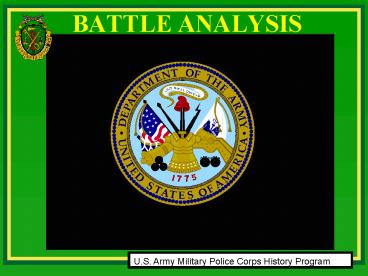BATTLE ANALYSIS - PowerPoint PPT Presentation
1 / 20
Title:
BATTLE ANALYSIS
Description:
Coral reef--Marines. required to wade 400-500. yards to the beach. ... 1. Invasion set for low tide- coral reef stopped landing. crafts from reaching the beach. ... – PowerPoint PPT presentation
Number of Views:2455
Avg rating:3.0/5.0
Title: BATTLE ANALYSIS
1
BATTLE ANALYSIS
2
TARAWA- 20-23 NOVEMBER 1943
Tarawa- Heavily Fortified with large caliber
harbor defense guns and defended by over 4,800
Japanese
3
Landing at low tide. Coral reef--Marines
required to wade 400-500 yards to the beach.
Due to heavy defenses, Marines and equipment
packed on beachhead.
4
Marines dying on the beach
Breaking out of the beachhead and taking the
island
5
MISTAKES
1. Invasion set for low tide- coral reef stopped
landing crafts from reaching the beach. 2.
Ships too far from landing sites, craft required
to travel 3 ½ miles to island- targets for enemy
guns. 3. Overestimate the effect of naval
bombardment and aerial bombing on enemy
defenses. 4. Underestimate the enemys will to
fight- only 17 of over 4,800 Japanese
surrendered. 73 hours- American casualties
3,301
6
General George Patton, Jr.
Napoleon
Field Marshal Erwin Rommel
7
(No Transcript)
8
- PROVIDE ARM PROFESSIONALS WITH A
- COMMON FOUNDATION OF BASIC
- INSTRUCTION IN MILITARY HISTORY EDUCATION.
- PROVIDE A BASIS FOR ANALYZING
- CONTEMPORARY MILITARY SITUATIONS AND
- OPERATIONS AT VARIOUS COMMAND
- ECHELONS IN THE CONTEXT OF HISTORICAL
- PRECEDENTS.
- PROVIDE AN IN-DEPTH UNDERSTANDING OF AN
- APPRECIATION FOR THE NATURE OF WAR.
9
- STIMULATE AN INTEREST IN FURTHER STUDY
- OF MILITARY HISTORY
- AND ENCOURAGE THE DEVELOPMENT OF
- INDIVIDUAL READING PROGRAMS THAT WILL
- PROMOTE A MATURE, INFORMED CONCEPTION
- OF THE INDIVIDUALS ROLE AS A MEMBER OF
- THE PROFESSION OF ARMS.
10
RELEVANCE OF MILITARY HISTORY
- A Professional Military career is unique because
- you may study your skill field and the
- techniques of war but never have the opportunity
- to apply them.
- But you may also be called upon to practice
- it numerous times.
11
BATTLE ANALYSIS
- Battle Analysis is a systematic examination of a
Campaign, Battle, or Military Operation.
- Battle Armed conflict between two opposing
- forces.
- Analysis Examining the parts of something in
- detail to determine the elements of those parts
- and relationship among the components.
12
- The purpose of Battle Analysis instruction is
- to provide the military professional with a tool
- to be used along with---War Games, Computer
- Simulations, and Field Training Exercises
- for the purpose of understanding and evaluating
- past or Military Operations.
13
USES OF MILITARY HISTORY
- LESSONS LEARNED- HISTORY REPEATS ITSELF.
- TO PREVENT MISTAKES FROM REOCCURRING,
- WE MUST LEARN FROM THE PAST.
- EXAMPLE- REPEATS- GENERAL PATTONS 3RD
- ARMY EXPERIENCED LOGISTICAL PROBLEMS
- WHEN THEY RAN OUT OF GAS WHILE RACING
- ACROSS GERMANY IN 1945 AND THE ARMY
- EXPERIENCED THE SAME PROBLEMS IN THE
- RACE ACROSS THE DESERT IN THE GULF WAR.
14
OBJECTIVES
- Learn more about Profession of Arms
- Better understand Problems of
- Tactics----Logistics
- Military Intelligence---Leadership
- Develop useful Theories, Ideas, and
Interpretations about Practice of Profession - Understand Challenge and Requirements of Combat
Leadership - Understand Intricacies of Waging Combined Arms
Warfare
15
MODELS FOR FRAMING THE ANALYSIS
- TENETS OF AIRLAND BATTLE
- PRINCIPLES OF WAR
- BATTLEFIELD OPERATING SYSTEMS
- AIR-LAND BATTLE IMPERATIVES
- STAFF FUNCTIONS
16
METHODOLOGY FORMAT
- Define the Subject
- Determine Date, Location, and Antagonists
- Determine the Sources
- Evaluate the Sources
- Review the Strategic Setting
- Determine Causes of Conflict
- Compare political, economic, religious, social
- and technological factors
17
METHODOLOGY FORMAT
- Review the Tactical Situation
- Area of Operations
- Climate and Weather
- Terrain (OCOKA)
- OBSERVATION AND FIRE
- COVER AND CONCEALMENT
- OBSTACLES
- KEY TERRAIN
- AVENUES OF APPROACH
18
METHODOLOGY FORMAT
- Compare the Opposing Forces
- Size and Composition
- Technology
- Logistical and Administrative Systems
- Intelligence
- Command, Control, and Communications
- Doctrine and Training
- Condition and Morale
- Leadership
- State Military Objectives of EACH Side
- Consider Possible Courses of Action for EACH Side
19
METHODOLOGY FORMAT
- Describe the Action
- Initial Disposition of Forces--Opening Moves
- Outline Major Phases (Chronology)
- Describe Key Events
- State the Outcome
- Assess the Significance
- Immediate
- Long-Term
- Military Lessons Learned
20
CONCLUSION
- Battle Analysis is a systematic and logical way
of seeking historical insights for applications
to contemporary and future problems.



























![Hiranandani Hospital Kidney Transplant [Deep Analysis] PowerPoint PPT Presentation](https://s3.amazonaws.com/images.powershow.com/10094953.th0.jpg?_=20240809065)



![read[pdf] battle: the story of the bulge PowerPoint PPT Presentation](https://s3.amazonaws.com/images.powershow.com/10141196.th0.jpg?_=20240927051)